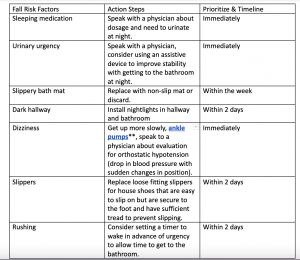Becoming A “Fall Prevention” Detective: Practical Advice From Expert Molly Roffman
May 19, 2021

As an agebuzz reader, you’re likely aware of the important advice we’ve shared from Balance and Falls Expert Molly Roffman. Whether it’s keeping us alert and upright, or sharing wisdom on how to regain strength and balance after the pandemic activity pause, Molly’s got essential information to help us all stay steady and avoid falling. Today, she’s sharing her insights into how to be a “Fall Detective,” i.e, examining the circumstances of your fall so as to avoid another episode going forward.
Becoming a Fall Prevention Detective by Molly Roffman
Preventing falls is like detective work. The circumstances of a fall contain important clues to the factors that contributed to it. We can use our powers of deduction to uncover the clues that lead to these risk factors so that we can take action to prevent a future fall.
Here’s how to use your powers of deduction to become a fall prevention detective! You can do this exercise on your own or you can interview a friend or family member.
– Think about a fall or an episode of loss of balance that you’ve had. Write down the circumstances of your fall in detail. Use the items listed below as a guide.
Include the setting and circumstances:
-Time of day
-Lighting (ex: brightly lit, very dark, poorly lit, blinding sunlight, etc.)
-Location (ex: doorway, staircase, outside/inside, home, kitchen, etc.)
-Activity (ex: getting dressed, walking the dog, turning, crossing a busy street, etc.)
-Accessibility (ex: availability of ramps, handrails, etc.)
-Terrain (ex: ice, wet/slippery, obstacles, uneven ground, etc.)
-Environment (ex: crowded, pressured, noisy, hurried, unfamiliar, etc.)
-Footwear (ex: socks, slippers, flip flops, etc.)
-Use of assistive devices (cane, walker, etc.)
-Encumbered: (heavy purse and/or shopping bags, etc.)
-Glasses (with/without, new prescription, etc.)
Include your mood and stress level:
-Stress level: (ex: hurried, sleep-deprived, etc.)
-Multitasking (ex: walking while talking on the phone)
-Medications (ex: How many medications? New medication?)
-Emotional state (ex. depressed, fatigued, distracted, etc.)
-Presence of illness (chronic, acute)
-Presence of Injury
-Pain (chronic, acute, location)
-Level of confidence with your ability to accomplish the activity safely.
Then, identify and list each of the factors that could have contributed to the fall.
-Next to each item, write down what action steps can be taken to address each of these items to prevent a future fall.
-Prioritize this list and create a timeline for addressing each item.
EXAMPLE: Fall Prevention Detective Notes
I woke up in the middle of the night needing to go to the bathroom, I sat up and then stood up quickly, stepped into slippers, and rushed down a dark hallway to the bathroom feeling light-headed. My slipper got caught on the edge of the bathmat and I fell. I took a sleeping pill before falling asleep.

**click here to learn about ankle pumps
A fall is a stressful and potentially traumatic event that we often want to put behind us but falls also provide valuable clues to the prevention of a future fall. Approaching a fall like a detective helps us to uncover the valuable clues that lead us to the factors that put us at risk. Understanding these factors and taking action to minimize them is crucial to ‘solving the fall’ and preventing future falls. Becoming a fall prevention detective also helps us to take control over our ability to prevent falls. Falls are preventable!
Molly Roffman, PT, MA, CEEAA is the founder and director of StepWISEnow Balance Fitness. She is a licensed New York State physical therapist specializing in fall prevention and balance training. Molly’s experience in the rehabilitation of patients who sustained fractures and other fall-related injuries inspired her to develop StepWISEnow.







